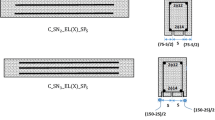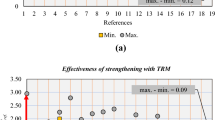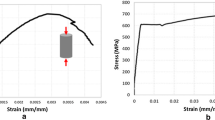Abstract
In this paper, an experimental investigation into the shear strengthening of damaged rectangular reinforced concrete (RC) beams using two near-surface mounted (NSM) fiber reinforced polymer (FRP) bar systems is presented. In addition to the epoxy adhesive, which is typically used to bond the FRP bars to the RC, in this study a novel mortar-based adhesive was tested. The parameters investigated in this study include (a) adhesive used (epoxy or mortar) and (b) level of damage (no damage, first shear crack, or 70% of maximum theoretical load). For this endeavor, seven 2 m-long RC beams were cast and tested in three-point bending. From the results, it was observed that (a) both strengthening systems were able to overcome the effects of the damage and provide substantial increases to the beams’ shear capacity; (b) both systems were able to restore the damaged beams’ stiffness to their original values; (c) the mortar-mounted bars were less effective compared to their epoxy-mounted counterparts.
Access provided by Autonomous University of Puebla. Download conference paper PDF
Similar content being viewed by others
1 Introduction
One of the most efficient ways to combat the infrastructure gap around the world is to repair damaged structures rather than replace them. In one study, it was found that repairing a structure versus replacing it had only 10% of the cost (GangaRao et al. 2006). One commonly used repair method for reinforced concrete (RC) structures is near-surface mounted (NSM) fiber reinforced polymer (FRP) bars. In this process, polymer-based adhesive is used to mount the FRP bars to the concrete.
Mortar-based adhesives feature several benefits over the two-part epoxy. These benefits include reduced cost, improved fire resistance, and the ability to be applied to cold or wet surfaces. There have been several studies (Bilotta et al. 2011; Sharaky et al. 2014) that demonstrate the effectiveness of mortar for mounting NSM FRP bars.
One of the most important areas of structural repair is shear strengthening. The shear failure mode is catastrophic, therefore structures with the capacity to resist this failure mode are vital. While there are many studies into the shear strengthening of RC using NSM FRP bars (Dias and Barros 2012; Jalali et al. 2012), only a few studies reported the use of mortar-mounted FRP NSM bars. The studies showed that mortar-mounted bars were able to increase the shear capacity of RC beams, however, they were only 80% as effective as the epoxy-mounted system (Al-Mahmoud et al. 2015). In many cases, structural deficiency is only detected after some damage is sustained. However, there is a limited amount of literature on RC repair of specimens damaged in shear using NSM FRP bars (Dias and Barros 2012).
In this study, the effectiveness of NSM FRP bars mounted with mortar and epoxy adhesives was examined. In order to simulate a real-world strengthening scenario, some of the beams were damaged before being repaired.
2 Experimental Program
2.1 Investigated Parameters and Test Specimens
The key parameters investigated in this study were (a) The effect of adhesive material and (b) the effect of damage. Two different adhesive materials were used: two-part epoxy and inorganic cementitious mortar. Three levels of damage were tested: undamaged, first shear crack, and 70% of maximum theoretical load.
To investigate these parameters, seven beams were tested (Table 1). The naming scheme for the specimens is X-DY, with X denoting the strengthening scheme used (N for no strengthening, E for epoxy mounted rods, and M for mortar mounted rods) and DY denotes the level of damage (D0 for no damage, D1 for first shear crack, and D2 for 70% of maximum theoretical load).
One beam, specimen N-D0, received no strengthening and acted as a control specimen. Two beams were strengthened using the different adhesives without damage, while the other four beams were strengthened after they were damaged (Table 1).
The beams were tested in three-point asymmetric bending. The total beam length was 2000 mm, with a flexural span of 1500 mm (Fig. 1). The depth of the beams was 265 mm and the width was 200 mm (Fig. 1). A concrete cover of 19 mm was provided on the sides and 25 mm on the top and bottom of the beam’s cross-section. In order to simulate a shear deficient beam, stirrup spacings larger than those allowed by CSA A23.3–14 were used in the shear critical section of the beam. The shear critical section had a span of 500 mm; this resulted in a span-to-depth (a/d) ratio of 2.3, which was held constant for all tests. The shear reinforcement consisted of 6 mm smooth bars spaced at 150 mm in the shear critical section and 100 mm elsewhere. To avoid flexural failure, the beams were reinforced in flexure with 2–25 M bars.
2.2 Material Properties
All of the specimens were cast using the same batch of ready-mix concrete from a local supplier. At the time of beams’ testing, the compressive strength of the concrete was verified using standard 100 mm × 200 mm cylinders as 45 MPa.
The 25 M bars used for longitudinal reinforcement had a yield strength, ultimate strength, and rupture strain of 471.6 MPa, 613.9 MPa, and 15.3%, respectively. The 6 mm rods used as stirrups had a yield strength of 340 MPa, ultimate strength of 482 MPa, and ultimate strain of 37.0%. The supplier provided the reported steel properties.
Basalt FRP bars with a diameter of 6 mm were used for both strengthening systems. The average tensile strength of the bars was 1231 MPa and the modulus of elasticity was 46.6GPa (Akiel 2016). In order to mount the bars, the first adhesive used was a two-part epoxy. The two-part epoxy was reported by the manufacturer to reach its full strength at 14 days with tensile and compressive strengths of 24.8 MPa and 59.3 MPa, respectively. The second adhesive was a cementitious mortar. The cementitious mortar was reported by the manufacturer to reach its full strength after 28 days with a tensile strength of 4.8 MPa and a compressive strength of 52 MPa.
2.3 Damage
Four specimens (M-D1, E-D1, M-D2, and E-D2) were damaged in three-point asymmetric bending before strengthening. The first damage level, which was the presence of the first shear crack, was detected by visual inspection of the specimen during loading, and correlated with a load of approximately 115kN for all specimens. The second level of damage, 70% of the maximum theoretical load of the control beam (147kN), was detected using the actuator’s load cell. Once the desired level of damage was achieved, the beams were unloaded and strengthened. After being strengthened, the beams were loaded to failure.
2.4 Strengthening
In order to assess the effectiveness of the various strengthening systems, NSM bars were applied to the shear critical sections of the beams in order to increase their shear capacity. The first step of strengthening was creating the grooves in which the bars were to be mounted. These grooves were 15 mm deep and 15 mm wide. They were made at a spacing of 150 mm in order to be positioned between the stirrups (Fig. 1). The epoxy-mounted bars were cured in open air for 28 days prior to testing. The mortar-mounted bars were cured under wet burlap for 7 days and then cured in open air for the remaining 21 days.
2.5 Test Setup and Procedure
The load was monotonically applied at a displacement-controlled rate of 2 mm/minute. A horizontally positioned 500kN-capacity hydraulic actuator was used to apply the load at a distance of 500 mm from the support on the shear critical end (Fig. 2). In order to measure the displacement of the beam, a linear potentiometer was utilized. The potentiometer was placed at the mid-span of the beam (Fig. 2). All data collection was synchronized and recorded using a computer software system. Failure of the specimens was taken as a 20% drop compared to the peak load.
3 Experimental Results and Discussion
The key results of the test are presented in Table 1. The key results include failure mode and peak load. The shear critical sections of the failed beams are shown in Fig. 3. The load–deflection curves of the specimens are plotted in Fig. 4.
3.1 Failure Mode
For the control beam, specimen N-D0, at a load of 115kN a large diagonal crack formed across the shear critical section. As the load increased, the crack widened until the beam lost load-bearing capacity. The beam failed in shear induced diagonal tension at an ultimate load of 217kN. The final state of Beam N-D0 is shown in Fig. 3.
For all of the beams in the epoxy group, the first shear crack was visible in the shear critical section at a load of 115kN. In Beam E-D2 as the load increased the shear crack grew, and a shear crack also opened in the non-critical shear section of the beam. Additionally, multiple flexure cracks opened along the length of the beam. At 320kN the longitudinal steel bars yielded causing the load to drop slightly (Fig. 4). Following a period of load plateau, the beam failed due to combined shear and flexure at 312kN, observed by crushing of the concrete compression block as shown in Fig. 3. Beams E-D0 and E-D1 failed due to debonding of the strengthening bars closest to the support at a load of approximately 290kN, followed by diagonal tension failure as shown in Fig. 3.
In all of the mortar-strengthened beams, the first shear crack was visible at loads between 115 and 125kN. In the mortar-strengthened specimens, the middle set of bars was the first to debond beginning at 155kN for Beams M-D0 and M-D1 and 255kN for Beam M-D2. Beams M-D1 and M-D2 failed in diagonal tension following the debonding of one of the sets of bars. For Beam M-D1, the strengthening bars closest to the point load debonded at 309kN and for Beam M-D2, the middle set of bars debonded at 267kN. In Beam M-D0, the middle set of bars showed substantial debonding between 155 and 212kN, at which point the load dropped. The load did not drop by more than 20% however (Fig. 4), so the test was continued until the beam failed in diagonal tension. The mortar-strengthened beams after testing are shown in Fig. 3.
3.2 Peak Loads
All of the specimens, except Beam M-D0, which is discussed below, displayed a substantial increase in shear capacity (25–49% compared to the control load). The load increases for the epoxy group were 42, 35, and 49% compared to the control load, for Beams E-D0, E-D1, and E-D2, respectively. Beam E-D1, which exhibited the lowest peak load, also experienced the most sudden failure. The load increases for the mortar group were −2.0, 43, and 25% compared to the control load, for Beams M-D0, M-D1, and M-D2, respectively. Beam M-D0 showed a peak load slightly lower than that of the control specimen. This was due to the premature debonding of the FRP bars before the control beam’s peak load was reached. Beam M-D2 experienced a more sudden failure than Beam M-D1 and showed a lower load-bearing capacity.
3.3 Effect of Damage
In Fig. 5, a comparison of damage level and peak load is plotted. It can be seen that there is no correlation between the level of damage and the effectiveness of the strengthening system. This confirms the findings of Dias and Barros (2012). In order to see if the stiffness decrease associated with damaged beams reported by Dias and Barros (2012) was also observed, beams’ stiffness before and after damage and repair, normalized to the control value, were plotted in Fig. 6. Except for Beam M-D1, which showed an abnormally high level of initial stiffness, the strengthened beams were able to retain the initial stiffness.
3.4 Effect of Mortar Versus Epoxy Adhesive
The average strength gain of the mortar system was only 86% of that of the epoxy system, similar to the findings of Al-Mahmoud et al. (2015). If specimen M-D0, which prematurely debonded, is disregarded the comparison is more favorable, with the mortar-strengthened beams reaching 94% of the effectiveness of their epoxy counterparts. In Fig. 6, the beams’ stiffness normalized to the control beam is plotted and grouped by strengthening type. It can be observed that all of the epoxy and the damaged mortar systems had no effect on stiffness value. The undamaged mortar specimen exhibited a slight increase in stiffness of approximately 10%.
4 Conclusions
Based on the discussion presented, the main findings of this investigation are
-
All the NSM FRP systems tested were able to increase the shear capacity of the deficient beams, with an average increase of 22% for mortar adhered FRP bars and 42% for epoxy adhered FRP bars.
-
The mortar system was shown to be more prone to premature debonding.
-
Both types of adhesive were fully functional irrespective of the level of damage.
-
Both types of adhesive were able to restore the beams’ original levels of stiffness.
References
Akiel MS (2016) Performance of continuous concrete slabs reinforced with hybrid steel-basalt bars. United Arab Emirates University, Abu Dhabi
Al-Mahmoud F, Castel A, Minh TQ, Francois R (2015) Reinforced concrete beams strengthened with NSM CFRP rods in shear. Adv Struct Eng 18 (10)
Bilotta A, Ceroni F, Di Ludovico M, Nigro E (2011) Bond efficiency of EBR and NSM FRP systems for strengthening concrete members. J Compos Constr 15(5):757–772
Dias SJ, Barros JA (2012) NSM shear strengthening technique with CFRP laminates appliedin high-strength concrete beams with or without pre-cracking. Compos Part B 290–301
GangaRao HV, Taly N, Vijay PV (2006) reinforced concrete design with FRP composites. CRC Press, Boca Raton
Jalali M, Sharbatdar MK, Chen JF, Alaee FJ (2012) Shear strengthening of RC beams using innovative manually made NSM FRP bars. Constr Build Mater 990–1000
Sharaky IA, Torres L, Comas J, Barris C (2014) Flexural response of reinforced concrete (RC) beams strengthened with near surface mounted (NSM) fibre reinforced polymer (FRP) bars. Compos Struct 109:8–22
Author information
Authors and Affiliations
Corresponding author
Editor information
Editors and Affiliations
Rights and permissions
Copyright information
© 2023 Canadian Society for Civil Engineering
About this paper
Cite this paper
Kennedy, D., Rteil, A. (2023). Effect of Near-Surface Mounted Adhesive on Shear Damaged Reinforced Concrete Beams. In: Benmokrane, B., Mohamed, K., Farghaly, A., Mohamed, H. (eds) 8th International Conference on Advanced Composite Materials in Bridges and Structures. Lecture Notes in Civil Engineering, vol 278. Springer, Cham. https://doi.org/10.1007/978-3-031-09632-7_2
Download citation
DOI: https://doi.org/10.1007/978-3-031-09632-7_2
Published:
Publisher Name: Springer, Cham
Print ISBN: 978-3-031-09631-0
Online ISBN: 978-3-031-09632-7
eBook Packages: EngineeringEngineering (R0)










